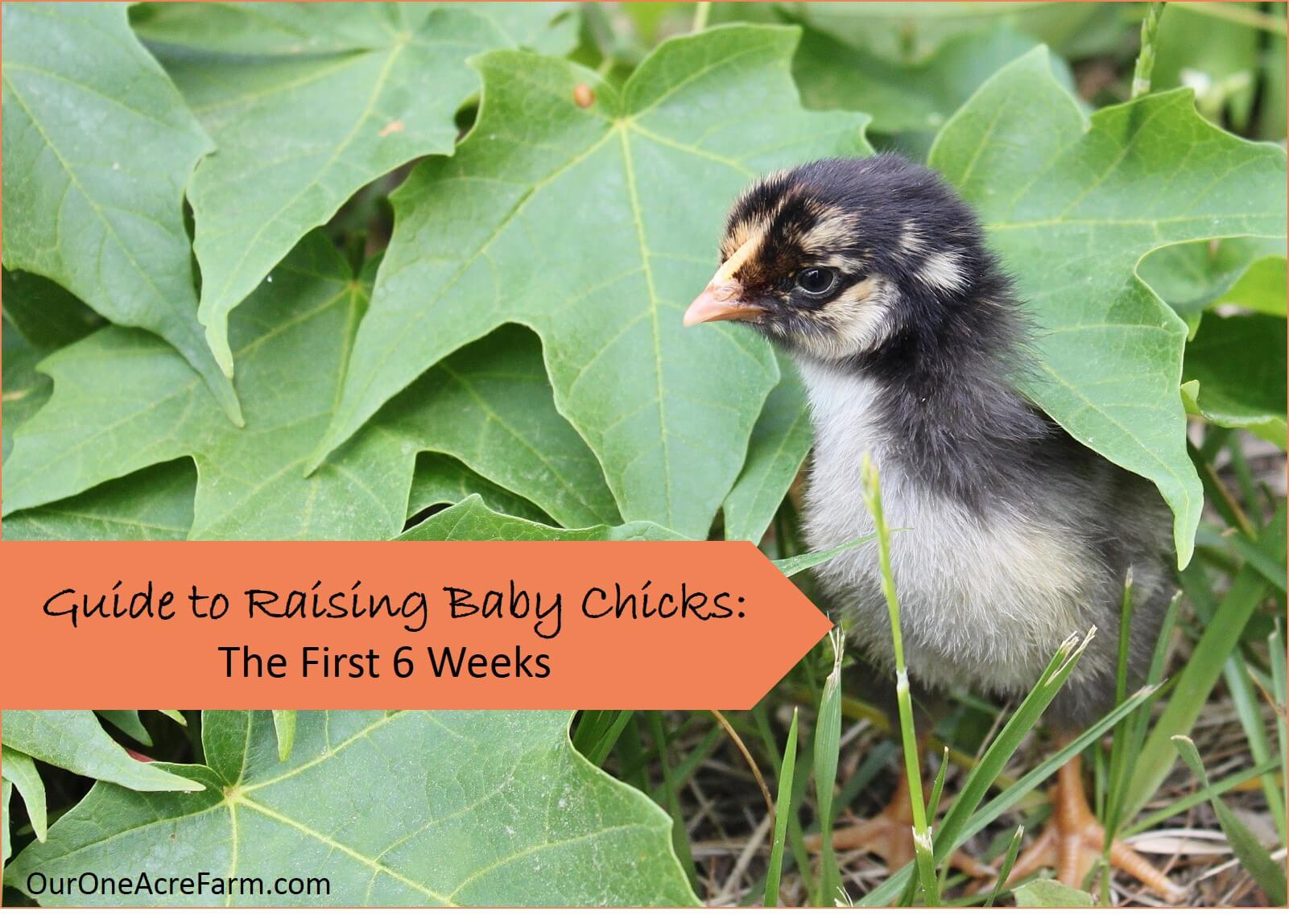
A 2-day old golden laced Wyandotte chick explores greenery for the first time.
Few things are as exciting as baby animals on the farm in spring. I add a few chicks to our flock about every other year, and I’m delighted that this year is a chick year. This year, like most years, I bought them from a hatchery. But when we had a rooster to fertilize the eggs, one of our hens hatched and raised 3 chicks. Seeing how a hen does her job gave me a better understanding of my job raising chicks in a brooder, and I believe I’m a better chick mom because of her. So here’s my guide to raising baby chicks without a hen, with insight gained from a little bantam hen who did it the old fashioned way.
Raising Baby Chicks Without A Hen: The First 6 Weeks
This concise but thorough guide to raising baby chicks covers the following:
- Buying day-old baby chicks
- When to start your chicks
- What you need
- Setting up the brooder
- Chick arrival day
- The first few days
- The first 6 weeks: warmth, space, and stimulation
1. Buying day-old chicks
People new to chickens are often shocked that baby chicks are routinely packed in a box and sent through the mail without eating or drinking during a 1-3 day journey. This is possible because just prior to hatching, baby birds absorb the yolk sac, which provides sufficient nourishment for a few days days. Why should baby birds be capable of surviving a few days without food? Because in the wild, all of the eggs in a nest do not usually hatch on the same day. They hatch over a few days. So in order to hatch the entire clutch, the hen must continue to brood the slow pokes, even after the early birds hatch. Those early birds, nourished by the yolk sac, can sit tight with the unhatched eggs under the hen as she broods. When all or most of the eggs have hatched, the hen brings all her chicks to begin foraging.
Most backyard flock masters buy their chicks from a hatchery or local farm and garden store. I prefer ordering my chicks directly from the hatchery for these reasons:
- Local farm and garden stores get their chicks from hatcheries, so the chick has to be transported twice – from the hatchery to the store, and then from the store to my brooder. I prefer to subject the chicks to as little stress as possible.
- Local farm and garden stores usually order a very limited selection of breeds, while some of the hatcheries have a large selection. Order directly from the hatchery, and you can get what you want.
- Local farm and garden stores usually have chicks available for a limited time in spring. In my area (MA), this is early-mid spring. I prefer to start my chicks in late May, by which time the stores here no longer sell them.
- If you order directly from the hatchery, you can request that chicks be vaccinated or not be vaccinated.
You’ll probably find several hatcheries which offer the breed(s) you want, so to narrow down your source, try to determine how long it will take the chicks to get from the hatchery to your post office. It makes a significant difference in the health of the chicks at the time of arrival. I’ve experienced chicks with 1, 2 and 3 nights in transit. All chicks in the 1 night group were perky. Some chicks of the 2 night groups were a bit droopy, and some in the 3 night group were dead on arrival. Ask which days of the week they mail the chicks. My 3-night transit batch of chicks came from a hatchery which mailed chicks only on Saturday. Sunday is an off day, adding an extra day for the chicks. I never ordered from them again.
One disadvantage to buying chicks from a hatchery is the minimum order size. To ensure that the chicks will keep warm while in transit, many hatcheries have a minimum order size of 25 chicks. If your order is too small, the hatchery will add “males for warmth”. Most people don’t want these roosters. However, it may be possible to find a few people in town with whom you can place a joint order. And if you can’t, try Meyer Hatchery or My Pet Chicken, which fill small orders for a premium price, adding hand warmers, instead of extra males, for warmth. Or, buy the chicks from a local farm or store.
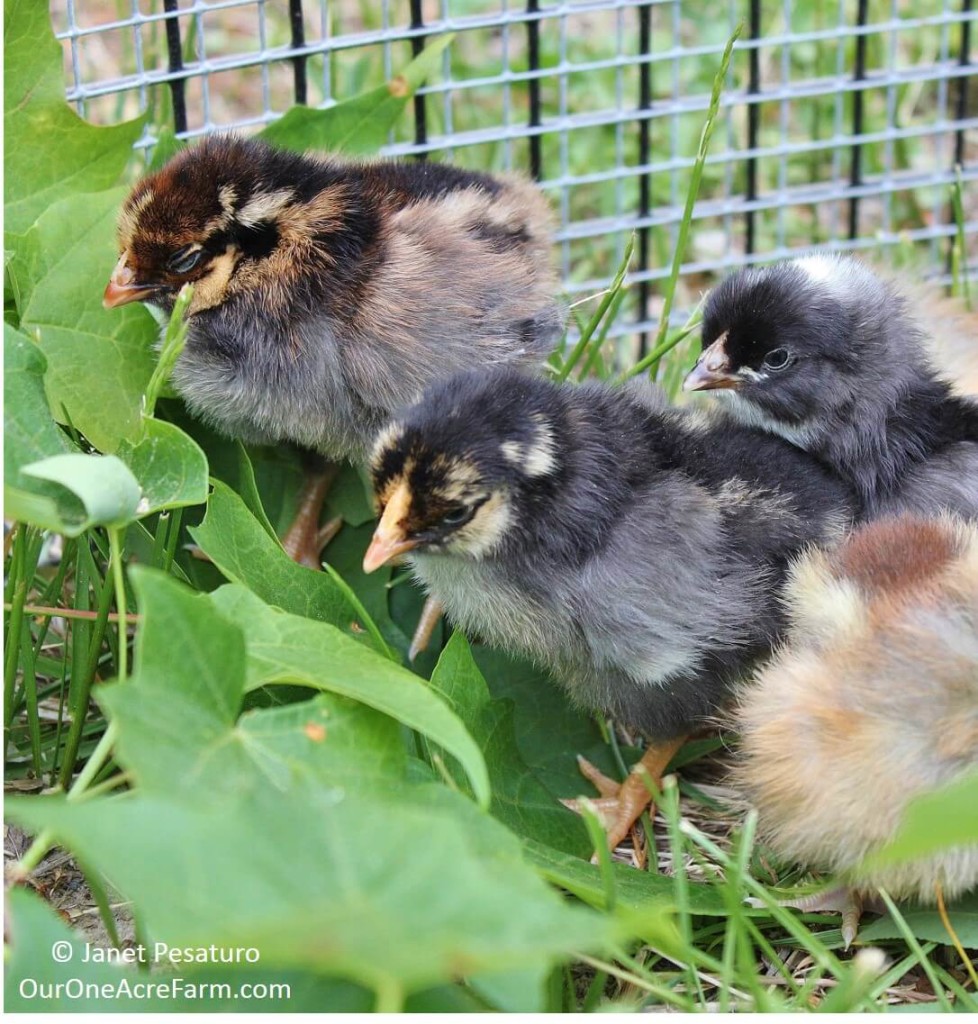
I prefer to start chicks in mid-late spring, so chicks can have some outdoor time during the warmth of the afternoon.
2. When to start your chicks
Unlike newly hatched chicks of many bird species, day old baby chickens can walk, eat, and drink on their own. But one thing they normally get from the hen and can’t live without, is warmth. You must provide that. As long as you are able to provide supplemental heat for as long as they need it, you can start chicks at any time of year. Here in Massachusetts, I prefer to start them in late May, because by then it’s warm enough to give the chicks a little outdoor access (in a protected areas). And, by mid-June, it’s warm enough for the chicks to spend most of the daylight hours outside. Many people, even here in New England, start them in early spring to be sure the females begin to lay eggs before winter, but that usually means the chicks spend much time confined to the brooder during those chilly spring days. Just be sure you’ve got plenty of brooder space, if you choose to raise them in cool weather.
3. What you need
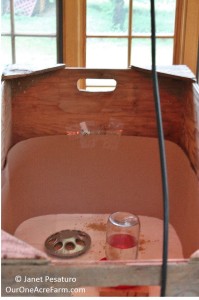
I brood our chicks in this 4 x 2 ft box in our sun room, where this is plenty of natural light.
A place to brood them. Some people brood them in the house for the first few weeks, in the basement, or in a barn, shed, etc. I use our sun room because it’s bright and sunny, well ventilated, and I can check the chicks during the night without going outside.
A brooder box – I prefer a long narrow shape, so I can provide a warm end to simulate the warmth of the hen, and a cool end for the chicks to explore as they feel comfortable (see below). Other possibilities for a brooder include a large plastic tub or a child’s swimming pool. Some people just use brooder guard (see below) on litter directly on the basement or shed floor.
A heat source which can maintain a temperature of 90-95 degrees F at one end of the brooder, and which can be raised and lowered so you can regulate temperature. If your brooder box is small, or if you are in a warm climate, you might need nothing more than 60 or 100 watt bulb. Here in Massachusetts, I need a 250 watt infrared heat lamp over my 8 square foot brooder box, even in spring. If you use one of these head lamps, take great care to mount it securely, as they are real fire risks! Another option is the Ohio Brooder, which you can make yourself (see sources).
A thermometer in the brooder box is a good idea. I tape an inexpensive one to the wall of the warm end of the brooder.
Light stimulates activity and eating, and therefore growth. If you raise your chicks in a dark basement under an infrared heat lamp, you’ll probably need to keep a regular light on during the day to keep them active. This is one reason I start mine in our sun room.
A brooder guard to protect from drafts and to prevent young chicks from piling up in a corner, potentially suffocating the bottom chick, to keep warm. You do not need this if your brooder has no corners (e.g., a child’s round swimming pool). I use brooder guard because my brooder is a box with 4 corners. You can make a brooder guard out of cardboard boxes, or buy a roll of it. You can see what it looks like in my photos. I typically remove it when chicks are 1-2 weeks old, strong enough to get out from under the other chicks, should they pile up.
A cover for the brooder which excludes cats and prevents older chicks from flying out, but allows exchange of air and penetration of light. I place an old screen over the brooder box.
Paper towel is an excellent bedding for at least the first 2 days, for several reasons:
- You can sprinkle the food on it, allowing the chicks to indulge their natural tendency to forage by pecking and scratching the ground. Eating from a feeder takes a little bit of learning, so it’s best to get them going in a way that comes naturally.
- It keeps them from eating litter, which can cause malnutrition, crop impaction, and constipation.
- It’s got enough friction so chicks won’t slip. Do not use newspaper (or other smooth paper), which is too slippery. Slipping can cause leg injury.
Bedding will be necessary once the paper towels are removed. One of the most common materials is pine shavings, which is what I use. Shavings are soft and absorbent, keeping the litter dry. Moist, poopy litter is a great substrate for the proliferation of pathogens (disease causing micro-organisms). Other inexpensive and widely available materials for bedding include crushed corn cobs and chopped straw. Whatever you use should be soft, absorbent, and nontoxic.
Ventilation is important for chickens of all ages. Poor ventilation, especially in a tight space, quickly results in build up of ammonia and excessive moisture, both of which can contribute to disease processes.
Food is an obvious necessity, and unless the chicks will have access to good habitat (high plant diversity), or unless you want to put some thought into developing a homemade balanced chick ration, I highly recommend commercial chick starter. There are many brands, and they contain 18-20% protein. A higher protein diet which is otherwise balanced for chicks is fine, but a lower protein diet will result protein deficiency. Do not feed them layer ration. It’s too low in protein and too high in calcium. Commercial chick feed is available unmedicated, or medicated. Medicated feed contains an anti-coccidial agent, which helps prevent coccidiosis, a common cause of diarrhea in chicks. I use medicated feed, because I brood chicks in late spring, when weather is warm enough allow proliferation of coccidia. The risk of coccidiosis is lower if you brood them in cool weather. Some hatcheries offer a vaccine for coccidiosis, making medicated feed (generally) unnecessary, and generally not recommended, since anti-coccidial medications can kill the organisms in the live vaccines that are typically used in backyard flocks. (However, this post is obviously not meant to be an in depth discussion of coccidiosis treatment and prevention. Consult additional sources for further information, and make your own decisions. I am not responsible for the death of your birds, however you choose to manage them.)
Chick feeders come in a variety of sizes and shapes. You might need a couple of different sizes, so you can switch to a larger one as the chicks grow. I start with small round feeders shown the photo. Be sure you have enough feeders for all chicks to feed at the same time. Place the feeder(s) near the warm end of the brooder, but not directly under the lamp. As the chicks grow, they spend more time away from the warm area, so move the feeder further towards the cool end of the brooder. When chicks are about 2 weeks old, I switch to a larger, hanging feeder. Then, when they move out to the coop (around 4-6 weeks), they are ready for an adult chicken feeder. I keep the top of the feeder covered with an inverted aluminum foil pie plate, as in the photo, to prevent chicks from standing on top and feeding from the reservoir. I adjust the height using the hooks as shown in the photo.
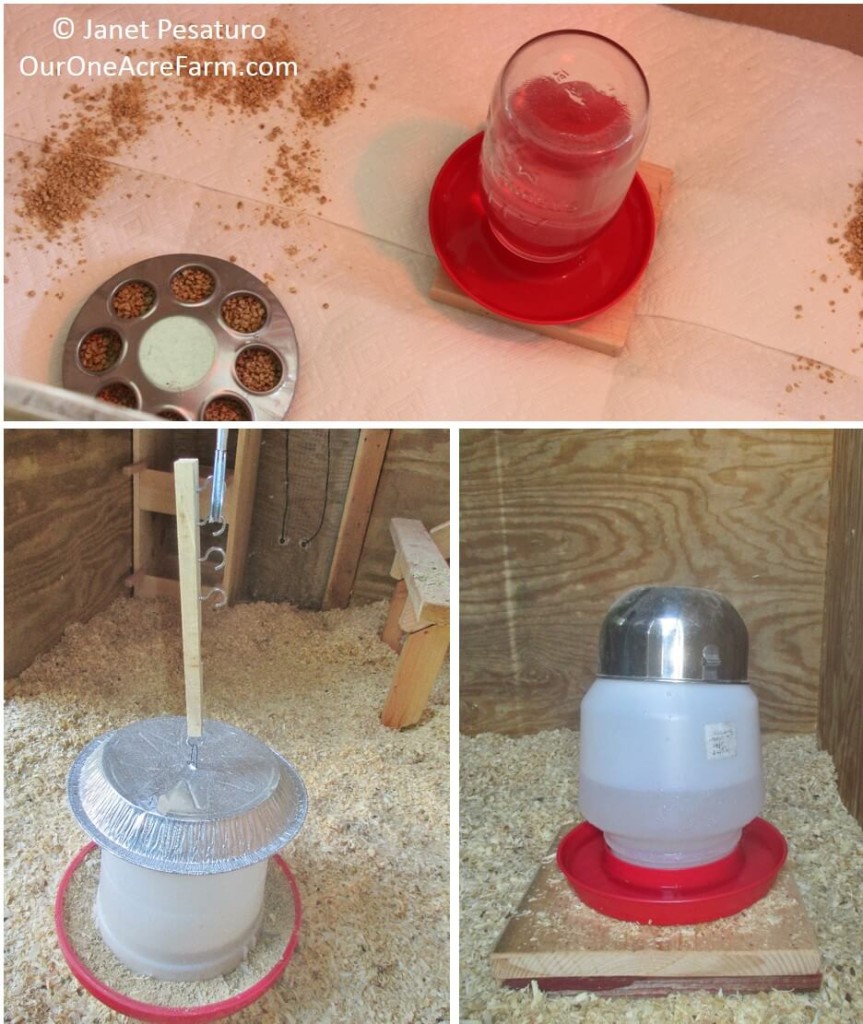
Clockwise from top left: Feeder for baby chicks; water fount for baby chicks; fount for older chicks with inverted bowl that prevents perching and boards that can be stacked to raise the fount; feeder for larger chicks and adults with inverted pie plate to prevent perching and a hanger that allows adjustment of height.
Chick grit should be offered if chicks do not have access to the outdoors, where they will ingest tiny stones in the dirt as they forage. It’s often said that they do not need grit if they are eating commercial chick feed (the contents of which have been finely ground), but I think it’s a good idea to get some grit into their gizzards as soon as possible. At some point, they will be going outdoors, or you will be giving them foods other than commercial feed, so it’s good to have grit already in the system.
A chick water fount is far better than an open tray of water into which the chicks can track litter and droppings. They can still scratch litter and droppings into the standard chick water fount, a 1 quart mason jar threaded into a plastic base (like the one in my photo), but they cannot walk through it or fall into it. Don’t use the plastic reservoir available for purchase with the base, as it is too light weight and can be knocked over by larger chicks. Eventually, chicks will try their developing wings and take great pride in perching atop the jar. That’s when it’s time for a larger fount, preferably one the prevents perching. I put a smooth metal bowl on the top of my water fount, because it’s too slippery for landing and perching. Notice also the shape of the reservoir of my water fount: it overhangs base, reducing the chance of litter and poop ending up in the water. Increase the height of the waterer as the chicks grow, to minimize contamination with litter, which they will inevitably scratch into it. I gradually stack 1 inch thick boards under the water fount, as you can see in the photo.
Water additives, such as electrolytes, vitamins, and probiotics designed for baby chicks, are good to have on hand in case your chicks spend a long time in transit, or simply appear droopy or otherwise stressed. Some commercial feeds have probiotics. Many people give their chicks a bit of yogurt for probiotics, but I’ve never done that because birds cannot the digest lactose in dairy products. Too much dairy could cause GI distress or even diarrhea.
A chicken coop, or a plan, at the very minimum, for housing your birds once they graduate from the brooder is an obvious necessity. Check out this Guide to Designing the Perfect Chicken Coop.
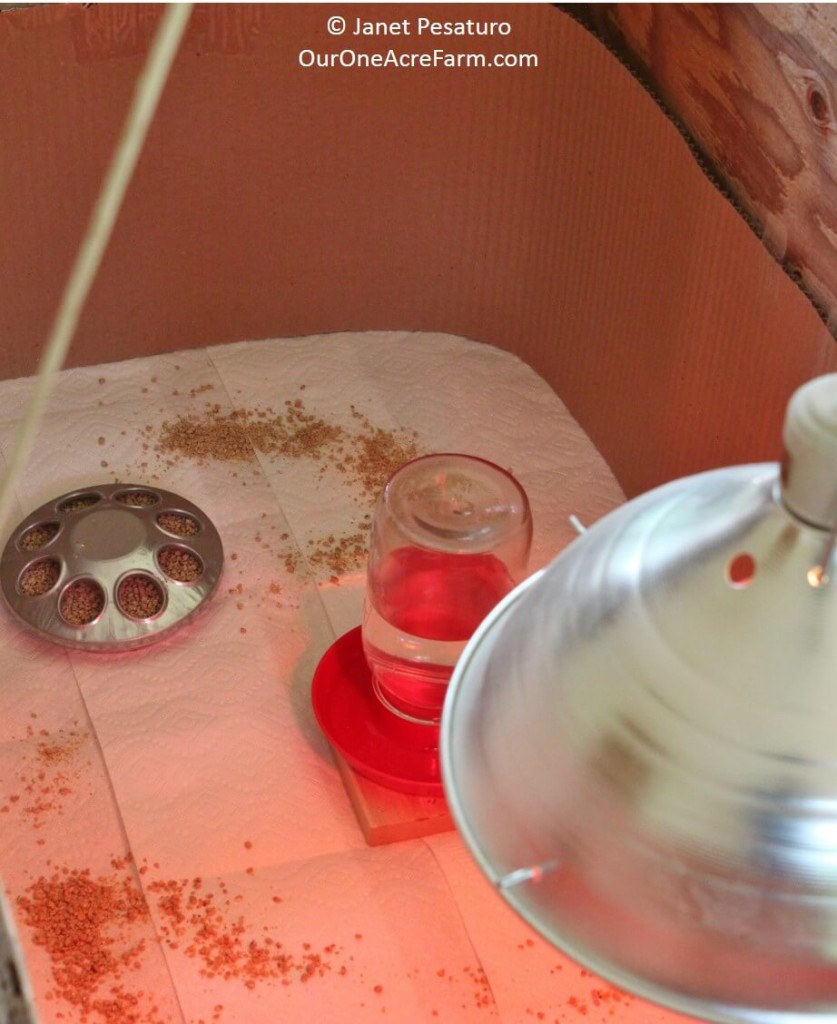
My brooder all ready for the chicks to arrive, with infrared heat lamp over one end of the rectangular box, feed sprinkled on paper towels, chick feeder, and chick water fount.
4. Setting up the brooder
I inherited an old 4 foot x 2 foot x 2 foot wooden box that was used as a brooder box at a nearby farm. I really like that rectangular shape, because you can keep the heat source over one end, so the chicks have the opportunity to venture off to the cooler end, and return to the warmer end when they want. This mimics life for chicks raised by a hen. They leave the warmth of her breast to forage with her for food, periodically stopping to warm up and nap beneath her.
Have your brooder box set up, with a layer of paper towels over the bedding and brooder guard in place. A few hours before your chicks are expected to arrive, turn on the heat source and adjust (the height, in the case of a bulb) until the temperature is 90-95 degrees F at the bottom of one end of the brooder. Right before you bring the chicks home, sprinkle some feed on the paper towels, and fill the feeder and water fount. I like to keep the fount in the middle of the box, so it’s easily accessible to chicks on both the cooler and warmer side of the box.
Keep in mind that the chicks need easy access to a 90-95 degree spot, but the entire brooder should not be that warm. You are trying to simulate an environment the chicks would have if raised by a hen. Chicks do not sit under the hen constantly. They spend a lot of time under the her warm body during their first few days, but go off with her to forage more frequently, and for longer periods of time, as they grow.
5. Chick Arrival Day
It’s a good idea to call your post office a day or two before the chicks are due, to request a phone call when the chicks arrive. Mine have always reached the post office in early morning, and I pick them up immediately. They come in a box like the one in the photo.
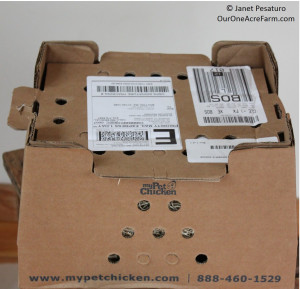
The typical box used to deliver chicks through the mail.
Gently remove chicks from the package one by one, dipping each one’s beak in water a few times before releasing it into the brooder box. Make sure they swallow the water: You can tell by the way they open and close their beaks a bit as they take in the water (my kids call that “chewing water”). Then watch them to make sure everyone is eating, drinking, and pooping. Watch to be sure they are comfortable with the temperature of the brooder. If they’re huddling together under the lamp, they’re too cold. If they’re staying as far as possible from the heat source, they’re too warm. Happy, healthy chicks will be eating, drinking, and running around with vim and vigor.
If any appear droopy, add electrolytes and vitamins to the water, if you haven’t already, and continue to dip the bird’s beak in water periodically. Some people even add sugar – about 1/3 cup per quart of water, to give them a burst of energy. What I put in the water depends on how long the chicks were in transit:
- For one night in transit, I added nothing to the water.
- For 2 nights in transit, I added vitamins, electrolytes, and probiotics.
- For 3 nights in transit, I added vitamins, electrolytes, probiotics, and sugar.
After the first 24-48 hours, I give them all plain water. I might resume one or all of these additives if chicks later develop problems.
6. The first few days
I keep the chicks in paper towels, changing them daily, for at least the first few days, and up to 2 weeks, depending on how the chicks are doing. That keeps the box clean, but more importantly, ensures that the chicks are eating food rather than litter. Provide a chick feeder too, though, so they’ll get used to it before you remove the paper towels and put them on litter. Continue to maintain a temperature of 90-95 degrees F in part of the box. Change the water daily, and more often if they get poop in it.
If the chicks had just a 1 night journey from the hatchery, all appear to be thriving, and the weather is warm (at least 80 degrees F) and mild, I might put them outside on greenery for an hour, as early as day #2. Here’s how I made a Baby Chick Playground. But don’t feel rushed. Chicks are delicate creatures, and those sent by mail have been subject to more stress than chicks under a hen. Keep an eye out for common chick problems, like diarrhea, constipation, toe picking, feather picking, and any other behavior that seems out of the ordinary.
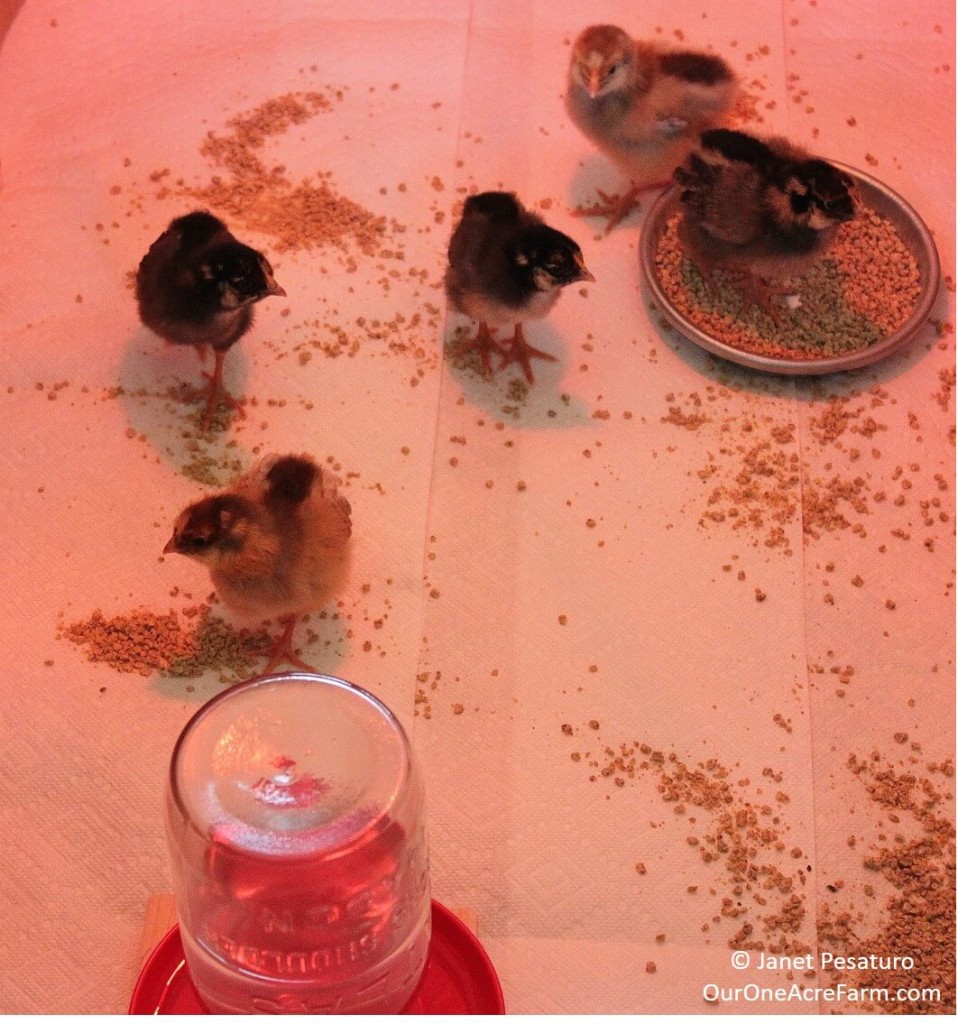
These chicks are active, they’re feeding, and they’re spaced out in the brooder, suggesting that the temperature is just right for them.
7. The First 6 Weeks: Warmth, Space, and Stimulation
Many sources say advise keeping the temperature (of part of the the chicks’ living area) at 90-95 degrees F for the entire first week, and reducing it by 5 degrees every week, until room temperature is reached. Doing a bit of math, this means on week 5, their warm up spot should be 70-75 degrees. Follow that if you feel you must, but I’ve found that chicks always progress more quickly than that. Mine avoid the 90-95 degree warm spot by the 3rd or 4th day, and seem to want the temperature to drop more quickly than 5 degrees per week. At this very moment, I have 5 week old chicks already in their coop with no supplemental heat, despite temperatures dipping to 60 degrees F at night. One of my neighbors routinely puts her chicks in the coop at 4 weeks, with no supplemental heat, and she starts hers earlier in spring.
Warmth and space are related. The more space the chicks have, the more heat is needed to keep it warm. Gail Damerow speaks to this relationship in her classic: “A Guide to Raising Chickens”. It’s a tremendously useful reference book, but its one short coming, in my opinion, is insufficient attention to the natural behaviors and preferences of chickens. Recommendations for spatial requirements are a glaring example. She recommends only 1/2 square foot of space per chick up to 4 weeks old, 1 square foot for 4-8 weeks old, 2 square feet for 8-12 weeks old, and about 3 square feet for 12+ weeks of age. She explains: “More isn’t necessarily better – if you give chicks too much space during cold weather, they’ll have trouble staying warm.
I disagree with that statement whole-heartedly. More space IS always better. I do not think it is humane to rely on the chicks huddling for warmth. Either provide sufficient supplemental heat, or raise chicks in warmer weather.

This 3-4 week old golden laced Wyandotte chick enjoys foraging with her 4 flock mates, among a diversity of plants in our 80 square foot enclosure.
According to the above spatial recommendations, in my 8 square ft brooder, I could keep 16 chicks up to 4 weeks of age. Picture that. It is very crowded, and with little stimulation other than each other, chicks are prone to toe picking and feather picking. This spring I raised 5 chicks in that 8 square ft box. That box sure didn’t give them the feeling of freedom and stimulation, for they erupted into joyful flight whenever I brought them to their 80 square foot outdoor enclosure.
Currently, my five 5-week old chicks occupy a 40 square ft coop and an 80 square ft run, for a total of 120 square ft. That’s 24 square feet per bird. It’s not freedom, but there’s enough space, vegetation, and insects to keep them actively foraging all day. And even that will be trampled to bare earth within a matter of weeks (a flock of 5 wild chickens living without handouts from humans would occupy about 12 acres, depending on habitat quality, as you can read in my post on Creating a Chicken Habitat). But by then, my young flock will be on limited free range in a large fenced yard.
So how much space you give your birds is your choice, but if you ever get to see how much they enjoy spacious habitat with good plant diversity, you might not feel good about the packing density commonly recommended in books.
Resources:
- Damerow, Gail. 1995. A Guide to Raising Chickens. Storey Communications, inc. Pownal, VT.
- How to Build an Ohio Brooder
Questions, comments, or tips for raising baby chicks? Make my day and leave a comment!
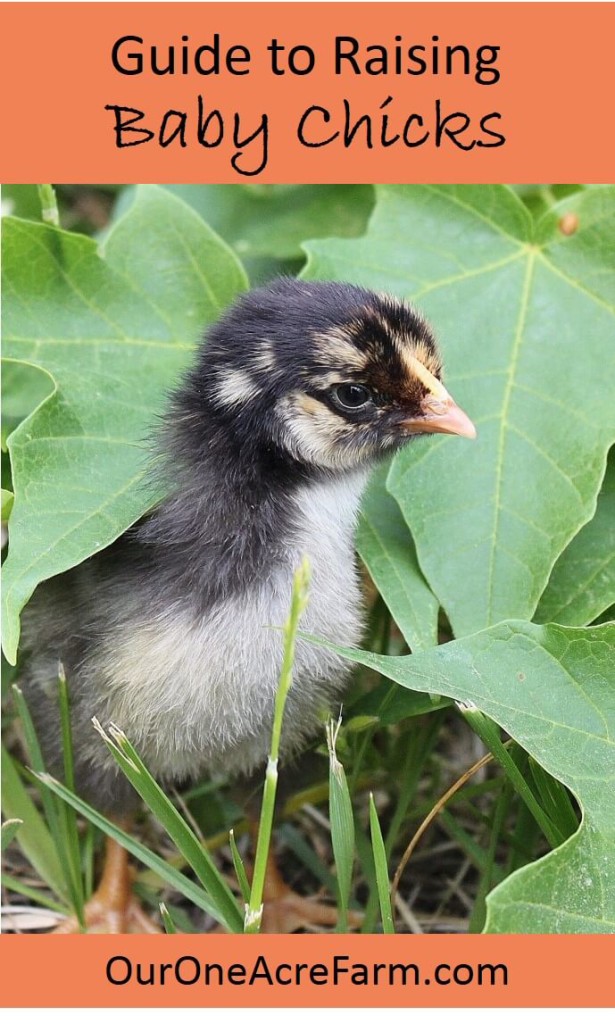
Please pin this image!











Great tips for beginners! We’re on our second batch of layers … they are 6 days old (and a few days ago were moving further away from the heat). We were going to get them earlier but did 25 meat birds in spring instead. They are in our living room right now and just like our first flock we are handling them as much as possible (but are finding it much harder as now we have 24 but 3 1/2 years ago we had 10!).
They are so curious and active, zipping around here and there nearly all day … and all night … long. Today we’ll try to take them out to the run, weather permitting.
Thanks for sharing!
Joanne
They’re so much fun, Joanne!! You make a good point about handling them frequently to socialize them – I should have said something about that in the post. Maybe I’ll edit it in. Thanks for stopping by!
Thanks for all the great info! I love your dual-purpose approach of feeding yourself and wildlife. I’m wondering what your favorite chicken breeds are (of those you’ve tried). We have a few breeds that are working really well for us in our cold climate (zone 4a): Orpingtons, Australorps, one Araucana and a red of some sort. We’ve been contemplating Buckeyes and a few other breeds. I always love to hear what others have tried.
Hi Maria, we are in zone 5b, so not quite as cold as where you are, but still cold snowy winters. Because of that, I prefer breeds with low, thick combs which are less susceptible to frostbite. I’ve raised wyandottes, brahmas, easter eggers, chanteclers, and a few others, but of all the breeds I’ve kept, those 4 are the best for our climate. Of those 4, wyandottes and easter eggers are the best layers. Buckeyes would be great, too, because they have small thick combs. I would also love to try dominiques sometime, as they are also very cold hardy birds with rose combs and are reputed to be excellent layers.
hey I am in zone 5a now and have 11 chantecler chicks purchased straight run entering week 5, when with chanteclers have you generally found that you can determine your pullets from your cockerels?
I’ve always chosen well tempered girls myself. Orphingtons, of course. I have a wonderful tempered Buckeye and recently got another one. I also like the temperament of the Wyndottes. I have a beauty of a Silver laced Wyandotte, and can’t wait to get a Blue laced Red Wyandotte. Sadly, I lost my Brahma. She was a gem and our mother hen, as she always watched over the rest of the girls. I recently got a Rhode Island Red. She was pecking at the other new baby chicks right off the bat, so, I returned her for another baby R.I. She seems to be more compatible with the other four baby chicks.
Hi Janet Thanks for making your website – it’s fantastic! I’m new to chickens – we haven’t got any yet. My hubby is slowly making a hen house from wood pallets. I plan on free ranging 4 layers in our 4000 square meter yard. I was thinking of getting plymouth/barred rocks because they are big enough to stop the cats from thinking they can chase them and the barred feathers are good camouflage in case of the occasional kestrel. What is your opinion on them? we live in south Spain (zone 10a)
Hi Elaine, barred rocks would be an excellent choice! I’ve had several of them, and in fact I have 2 at the moment. I’m in zone 5, so the single blade comb is a liability, but they’d be great for zone 10. They are calm, they lay very well, and as you point out, they are pretty well camouflaged with that barred pattern. 4000 sq meters – that’s about an acre, I think, which is a wonderfully generous area for a backyard flock.
I am delighted you enjoy my blog. I haven’t been posting much lately because I’ve had to tend to other things, but hope to get back to the blog soon.
Good luck with your flock!
Just found your site and let me just say…THANK YOU!! I have been reading a researching and your information has been the most helpful. We just moved to a 5 acre neglected farm and are starting to slightly build a homestead. We have 7 cats and I am just curious what advice you have as far as protecting these hens from them and also what rooster (if any) would you reccommend. I should also say we live in easter wa.
Thanks
Hi Tori, Most important thing is to keep cats away from baby chicks. Also it is safest to get standard sized chickens instead of bantams. It’s a rare cat that will pose a serious threat to a full sized adult chicken. 3 out of my 4 cats also leave adult bantam hens alone. One cat needs to be kept out of the chicken yard. Fortunately, he is not a climber, and never goes over our 4 ft fence. A standard sized rooster will protect hens from cats. A bantam roo may or may not. Roos are all individuals. Some are much better protectors than others. Some are also aggressive towards people, and they can hurt you with their spurs. Aggressive roosters and young children do not mix. I’ve had roos, but do not depend on them for predator protection, so I prefer a mellow breed. Your choice really depends on your particular situation.
Thank you so much!!! Such an amazing site!!!
Pingback: How To Raise Baby Chicks – A Website For All The Ideas You Will Ever Need
This information you’ve provided is fantastic and so detailed. We are about to go pick up two chicks (our first batch ever) and were a little nervous about it since we only have .18 acre and live in a city, but with these instructions I can’t wait! Thank you!! :).
You are very welcome, Nicole, and have fun with your chickens!
Can you say more about “stimulation” for chicks? do they need a swing (seen some examples!), or clipped grass, or?
Hi JK, the idea is to replicate as well as you can, the life chicks would have in the wild. They would be running and foraging within a diversity of vegetation. Plenty of space is a good start. If it’s cold out when your chicks are young, you can put grasses and other greenery (including lettuces) into the brooder box. I also like to put some small logs in the box for them to jump on and off. If it’s warm enough, you can give them some outdoor time in a protected enclosure with logs, branches, a small box for them to snuggle in. Here’s what I provide for outdoor entertainment: https://ouroneacrefarm.com/baby-chick-playground/
Great information! Any tips related to introducing your new chicks to an existing flock? We have nine veteran layers already occupying our coop and I’m wondering how to make introductions and at what age for the new chicks? Would it be a good idea to create a “fenced-off”, separate space for the new chicks to move into (once we’ve brooded them in our home) within the coop? Also, the chickens we have now spend all day free-range, when can we let the new girls participate alongside them out-of-coop?
Hi Amy, that is a big topic in and of itself, one which I plan to cover in a future post. In brief, the more gradual the introduction, the better. Yes, a separate space for the chicks, separated by a fence they can see through, is a great idea. I know some people go much more quickly, but I never have my new birds living full time and sleeping in the same coop as the older ones until the new ones are around 4-5 months old and appear to be about adult size. By the time they are 3 months old, I might have them outdoors for most of the day with the older ones, but then I put the young ones back in the brooder box just for the night. Going this slowly allows them to establish a peck order without overt aggression, so no one gets bullied. Hope that helps!
Thank you so much for all this information! We just bought our first batch of chicks (6 of them), and I have been looking at all different blogs and posts and yours has been by far the most helpful! Will handling the chicks help with keeping them in the yard once we switch them out to free roam? Is it beneficial to have a rooster? We live on 3/4 of an acre surrounded by fields, and see quite a few coyotes and coons around the neighborhood. I’ve heard getting a roo could be beneficial, but I don’t want to end up with an aggressive one that goes after my dogs when they are out. We are working on introducing the dogs to the chicks as they grow! Chicks are friends, NOT food!
Hi Shannon, in my experience, young chickens will range quite far if you don’t fence them in at all. And if they are loose all day, they may lay some of their eggs outside the coop, where you cannot find them, with the hopes of hatching them. Handling chicks them tame, but doesn’t make them stay in your yard. Offering them treats and training them to come when called helps you get them to return when you want them. See my post on training chickens. If you have coons and coyotes in your neighborhood, I would not let them free range. They will be coon and coyote bait and, eventually, dinner. A rooster will not be able to protect them from those predators. Coyotes and coons can be quite large, and often come in groups. A rooster is no match. See my post on “limited” free ranging.
Hello!
Such wonderful and valuable information! My boyfriend and I are doing plenty of research before including chickens into our little family. My big question is this: we have a decent sized backyard in the city and were thinking about 2 chickens would be happy back there. I am wondering your opinion on “urban” chickens? What advice would you give to keeping them happy and healthy?
Thank you!
Thanks, Elizabeth, I am delighted you found this useful! The more space and stimulation you can give them, the better. Check out the following article, which explains what chickens like, and you can satisfy their needs if space is limited: https://ouroneacrefarm.com/creating-chicken-habitat-advice-red-jungle-fowl/
Thank you so much! I just got chicks yesterday and I am so interested in learning more.
You are quite welcome. Good luck with your new chicks!
Temperature management in the brooder is the most important part of raising chicks. Thanks for the info!
Yes, temperature management is definitely very important. Glad you find this article useful!
Thank you for all of the tips! I am a first time chicken mom and I am having fun reading blogs just like this one!
we have 1 3 day chick and 1 that 1 day old the first one picks on the little one what do we do?
Hi Elizabeth, first try providing more space and stimulation. For ideas, check out my other posts:
Creating a Chicken Habitat
and:
Raising Baby Chicks Without a Hen
Hi Elizabeth, I had the same thing a 3day and 1day and the 3day old picked on the one day so we started holding them at the same time giving them a little space and letting them climb around when they got tired they cuddled together and slept. That was that. Now the little one even try’s to get under the other ones wing for warmth and comfort, but there is no more pecking or picking going on. I don’t know if it always works but it worked great for us, good luck;)
Pingback: Musings from the farm- Chickens! - Musings From The FarmMusings From The Farm
thanks for the ideas, I needed to know when you put your chicks in the chicken hut. thanks
Thank you for a great site and all the info. I’m new to chickens, but my fiance always goes BIG if he does something, having a bit of experiance himself with chickens, he’s gone ahead and ordered 50 chicks, Yip that’s right 50!!! As he works away from home , guess who will land up raising them….me. I was apprehensive before reading your site, now I must admit I’m starting to look forward to the challenge. Thank you for the helpful info and comments x
hi could i just put the chicks on only plain dried grass?
could i just feed them grains or bread and i need answers cause am confused
No, for litter they should have something absorbent and something they are not likely to try to eat. Grass matts up as droppings accumulate, and pieces of grass could impact their crops if they eat it. No, grains or bread are NOT a balanced diet for chicks. Using commercial baby chick feed is the easiest way to provide a balanced diet. You can make your own chick feed, but if you do, you should find a recipe for a balanced feed.
This article was so helpful for us yesterday. I’ve been raising chickens and chicks my whole life. I usually trade with a friend or hatch my own. I decided to order via online. The shipment was delayed, by a whole day and I was very concerned. I decided I would need to find an electrolyte recipe for them. That’s when I found this article. I really appreciated your recipe and knowledge of what to expect. It really settled my mind and nerves. I was so worried for them. They chicks all made it!!! They were 2 nights out. Take care, Heather
Under food in this article it states if you have the chicks vaccinated for Coccidia you don’t have to use Medicated Feed..That is false information..According to my Avian/ Agrarian Vet in Buckingham County the vaccine only covers 3 out of the 9 strains of Coccidia..still leaving the chicks completely susceptible to the other 6 strains. The hatchery told me NOT to use Medicated Feed because it would cancel out the vaccine..Again False information according to my Vet. I had 8 birds die because of this false information..I see this information all the time and it is very disheartening knowing that there will be alot of pain & suffering. I trust what my Vet says more than people just putting information out because they “think” they are right.
Just for the record. Chicks under 3 weeks of age CANNOT get Coccidia..if there are loose stools according to my Vet it is mostly always related to broader temps.
Perhaps it depends on exactly which vaccine and which anti-coccidial agent you are talking about.
Amprolium is the anti-coccidial agent available for use in backyard flocks, and used in all medicated feeds with which I am familiar.
The commonly available coccidia vaccine is CocciVac-D. It is a live vaccine which protects against, not just 3 species, as you claim, but 8 species (Eimeria tenella, E. mivati, E. acervulina, E. maxima, E. brunetti, E. hagani, E. necatrix, and E. praecox), as indicated here: https://www.drugs.com/vet/coccivac-d.html.
The pharmaceutical company which makes that vaccine says that amprolium may “interrupt the development of immunity, increasing the risk of later coccidial challenges” as you can read here: http://www.merck-animal-health-usa.com/binaries/TSB_432_Coccivac-D_Ensuring_and_monitoring_good_immunity_tcm96-43021.pdf
So, at least we can say that the commonly available medicated feed may, in fact, negate the effects of the commonly available vaccine for coccidia. Maybe your vet is talking about a different coccidia vaccine and/or a different anti-coccidial drug. Or perhaps you should find a new vet.
Keep in mind that coccidiosis vaccines in use for backyard flocks are live vaccines, meaning that they consist of live organisms. An anti-coccidial agent can kill these organisms, and as a result, the vaccine recipient might not develop immunity to the them.
Of course, some birds may get sick despite having received the vaccine. If that happens, use common sense and decide yourself whether or not you want to treat them.
I am excited…..my chicks will be here soon from a local hatchery.
I thank you you for all the useful information. My brooder is almost ready. I have been researching now for about a year on do and don’ts of raising chickens.I,m in the country and I love it.I am a little scared that I won,t do every thing correctly. Live and learn.I”ll let you know how things turn out. Beverly
Hi there. My 6yo son’s class has 3 chicks in his room, in a wooden box with a heat source etc. My overwhelming thought when I saw the wee things huddled together was “where is their soft comfort, their mama hen substitute?”. I know that baby monkeys prefer a soft, towelling ‘mother substitute’ over a wooden one that provides milk. I thought the chicks could do with a soft toy type thing, to huddle into together, and also, to have somewhere to hide. A hens wings would provide soft comfort, plus somewhere to hide from the outside world (something that contained cats also like). Thx, from Wanaka, Aoteroa New Zealand:)
I use a real feather duster taped to the side. Both my Quail and chickens love it. My crippled chick hides all day under it, except when she wants to be held.
We’re getting our first batch of chicks this spring. We are really excited to become chicky parents. This and other articles have been very helpful in getting ready for our babies. Thank you.
Hello,
About how often should we change the pine shavings in the brooder box? I have 4 day old chicks.
This article was so helpful, and also so fun to read!!! Cannot wait to read more. Today I brought home 14 chicks. Thanks for creating this site!!
Such a great read. I’ve had chickens for almost a year now and I’ve raised about 2 dozen chicks… it’s nice to have affirmation that what I am doing is what others recommend. I had an older lady tell me once that apple cider is a natural wormer for chicks and that she recommends putting that in their water for the first few weeks and then every now and again once they get older.
Also, if their poop sticks to them, they are too hot. She recommends using a 75 w bulb instead of a heat lamp…especially since we live in the Deep South. This may be of help to your readers that live in very warm areas. Looking forward to hearing more from you.
When I was young we had 60 chickens (give or take a couple more or less) foraging 15 acres of alfalfa, but I’m confident they would have benefited from even more space and variety. They were a healthy, thriving flock of happy birds who would break up into smaller cliques to make sure they covered their entire territory each day. I fully agree that when it comes to real estate, chickens can NEVER have too much.
Thank you for the great information!I found my chick in an empty pretzel bin in a parking lot with a bit of bread & cap of water. The note read, please take me home”. McNugget has been with us 6 weeks,and is a spoiled pet chicken! She’s even been to the vet for well visits.
Can a baby chick withstand temperatures at night of 40 degrees?
This chick was incubated so she does not have a mamma.
They have to be fully feathered to be that cold without a mother hen. My hen has her chicks out in that cold of weather, but sits on them if cold,then runs them back to the heated coop often.
Dear madam
This more informative
I’m having a problem with 1 of our chicks he/she has a part of her sticking out i think its the sexual organs but I’m not sure and have no idea how it happened he/she was bleeding but has slowed down to just a drop and the extended part is starting to turn grey still trying to eat and drink but I’m worried and have no clue as what to do he looks like he wants to go to the bathroom but hasn’t yet any help would be appreciated thanks
i praise you for your exellent advice.
Great tips! Thanks so much! We just got our first little flock yesterday. They all seem to be doing ok. But I fear boredom. Is there anything I should be doing to keep them from being bored?
Pingback: How to raise chicks without a hen?
Pingback: How to start raising chickens?
We have a coop with a run, though not too big, as we want to let them free range. Will they return to their coop/home at the end of the day? Our ducks would run free and by dusk they be back in their room in the barn where we would shut the door at night to keep predators out? Wondering if the chicks will do the same?
Thank you so much! This is very helpful for a first time nervous chickie mommy, like me! Blessings!
We have 2 roosters & 5 hens that are about 2 years old. When we introduce our new young hens at 4-5 months, will the roosters protect them as they do the older original hens?
I like to have my hens do the work of raising chicks for me… so if one of them goes broody this year, we might consider sneaking a couple of chicks under her. Otherwise, probably not. 20 is plenty for us!
First time chicken lady and I have so many questions. Is it ok to put chicks directly in the coop with food, water, heat, etc.. and with no hen?
I’m looking for information on how to care and teach my 3 orphaned chicks. They had mom for the first 4 wks and taught them a lot. I know there is a lot more they need. They have their own space in the coop and they do free range and get food. They hadn’t learned how to take care when it rains. They had mom to follow. I’ve had to find them and herd them to a safe dry place.
I have 20 chickens on 3/4 acre they take care of themselves roaming all over neighborhood all I do is feed them… I started with 5 in 2015…this is the first time I come across day old baby by himself let me pick him up. He was chirping away ξ sweet pea won’t take care of him. He’s eating drinking ξ keeping warm… In my house. My issue with him is his head doesn’t stay up all the time. His head is upside down? Is he gonna die?
Why does a mother abandon one chick out a her clutch? Does anyone know? This is my second time to find a very tiny abandoned chick. I cannot leave them where I find them (alone) and do my best to care for it.